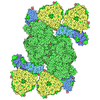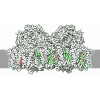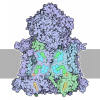[English] 日本語
 Yorodumi
Yorodumi- PDB-8iwx: Cryo-EM structure of unprotonated LHCII in detergent solution at ... -
+ Open data
Open data
- Basic information
Basic information
| Entry | Database: PDB / ID: 8iwx | ||||||||||||||||||||||||||||||||||||||||||||||||||||||
|---|---|---|---|---|---|---|---|---|---|---|---|---|---|---|---|---|---|---|---|---|---|---|---|---|---|---|---|---|---|---|---|---|---|---|---|---|---|---|---|---|---|---|---|---|---|---|---|---|---|---|---|---|---|---|---|
| Title | Cryo-EM structure of unprotonated LHCII in detergent solution at high pH value | ||||||||||||||||||||||||||||||||||||||||||||||||||||||
 Components Components | Chlorophyll a-b binding protein, chloroplastic | ||||||||||||||||||||||||||||||||||||||||||||||||||||||
 Keywords Keywords | PLANT PROTEIN / LHCII / Light-harvesting complex / Photosystem II | ||||||||||||||||||||||||||||||||||||||||||||||||||||||
| Function / homology |  Function and homology information Function and homology informationphotosynthesis, light harvesting in photosystem I / photosystem I / photosystem II / chlorophyll binding / chloroplast thylakoid membrane / response to light stimulus / metal ion binding Similarity search - Function | ||||||||||||||||||||||||||||||||||||||||||||||||||||||
| Biological species |  Spinacia oleracea (spinach) Spinacia oleracea (spinach) | ||||||||||||||||||||||||||||||||||||||||||||||||||||||
| Method | ELECTRON MICROSCOPY / single particle reconstruction / Resolution: 2.59 Å | ||||||||||||||||||||||||||||||||||||||||||||||||||||||
 Authors Authors | Ruan, M.X. / Ding, W. | ||||||||||||||||||||||||||||||||||||||||||||||||||||||
| Funding support |  China, 2items China, 2items
| ||||||||||||||||||||||||||||||||||||||||||||||||||||||
 Citation Citation |  Journal: Nat Plants / Year: 2023 Journal: Nat Plants / Year: 2023Title: Cryo-EM structures of LHCII in photo-active and photo-protecting states reveal allosteric regulation of light harvesting and excess energy dissipation. Authors: Meixia Ruan / Hao Li / Ying Zhang / Ruoqi Zhao / Jun Zhang / Yingjie Wang / Jiali Gao / Zhuan Wang / Yumei Wang / Dapeng Sun / Wei Ding / Yuxiang Weng /   Abstract: The major light-harvesting complex of photosystem II (LHCII) has a dual regulatory function in a process called non-photochemical quenching to avoid the formation of reactive oxygen. LHCII undergoes ...The major light-harvesting complex of photosystem II (LHCII) has a dual regulatory function in a process called non-photochemical quenching to avoid the formation of reactive oxygen. LHCII undergoes reversible conformation transitions to switch between a light-harvesting state for excited-state energy transfer and an energy-quenching state for dissipating excess energy under full sunshine. Here we report cryo-electron microscopy structures of LHCII in membrane nanodiscs, which mimic in vivo LHCII, and in detergent solution at pH 7.8 and 5.4, respectively. We found that, under low pH conditions, the salt bridges at the lumenal side of LHCII are broken, accompanied by the formation of two local α-helices on the lumen side. The formation of α-helices in turn triggers allosterically global protein conformational change, resulting in a smaller crossing angle between transmembrane helices. The fluorescence decay rates corresponding to different conformational states follow the Dexter energy transfer mechanism with a characteristic transition distance of 5.6 Å between Lut1 and Chl612. The experimental observations are consistent with the computed electronic coupling strengths using multistate density function theory. | ||||||||||||||||||||||||||||||||||||||||||||||||||||||
| History |
|
- Structure visualization
Structure visualization
| Structure viewer | Molecule:  Molmil Molmil Jmol/JSmol Jmol/JSmol |
|---|
- Downloads & links
Downloads & links
- Download
Download
| PDBx/mmCIF format |  8iwx.cif.gz 8iwx.cif.gz | 212.2 KB | Display |  PDBx/mmCIF format PDBx/mmCIF format |
|---|---|---|---|---|
| PDB format |  pdb8iwx.ent.gz pdb8iwx.ent.gz | 183.9 KB | Display |  PDB format PDB format |
| PDBx/mmJSON format |  8iwx.json.gz 8iwx.json.gz | Tree view |  PDBx/mmJSON format PDBx/mmJSON format | |
| Others |  Other downloads Other downloads |
-Validation report
| Summary document |  8iwx_validation.pdf.gz 8iwx_validation.pdf.gz | 3.6 MB | Display |  wwPDB validaton report wwPDB validaton report |
|---|---|---|---|---|
| Full document |  8iwx_full_validation.pdf.gz 8iwx_full_validation.pdf.gz | 3.7 MB | Display | |
| Data in XML |  8iwx_validation.xml.gz 8iwx_validation.xml.gz | 58.1 KB | Display | |
| Data in CIF |  8iwx_validation.cif.gz 8iwx_validation.cif.gz | 70.7 KB | Display | |
| Arichive directory |  https://data.pdbj.org/pub/pdb/validation_reports/iw/8iwx https://data.pdbj.org/pub/pdb/validation_reports/iw/8iwx ftp://data.pdbj.org/pub/pdb/validation_reports/iw/8iwx ftp://data.pdbj.org/pub/pdb/validation_reports/iw/8iwx | HTTPS FTP |
-Related structure data
| Related structure data |  35782MC  8iwyC  8iwzC  8ix0C  8ix1C  8ix2C M: map data used to model this data C: citing same article ( |
|---|---|
| Similar structure data | Similarity search - Function & homology  F&H Search F&H Search |
- Links
Links
- Assembly
Assembly
| Deposited unit | 
|
|---|---|
| 1 |
|
- Components
Components
-Protein , 1 types, 3 molecules NGY
| #1: Protein | Mass: 23497.549 Da / Num. of mol.: 3 Source method: isolated from a genetically manipulated source Source: (gene. exp.)  Spinacia oleracea (spinach) / Production host: Spinacia oleracea (spinach) / Production host:  Spinacia oleracea (spinach) / References: UniProt: P12333 Spinacia oleracea (spinach) / References: UniProt: P12333 |
|---|
-Non-polymers , 6 types, 57 molecules 










| #2: Chemical | ChemComp-CHL / #3: Chemical | ChemComp-CLA / #4: Chemical | ChemComp-LUT / ( #5: Chemical | #6: Chemical | #7: Chemical | |
|---|
-Details
| Has ligand of interest | Y |
|---|---|
| Has protein modification | N |
-Experimental details
-Experiment
| Experiment | Method: ELECTRON MICROSCOPY |
|---|---|
| EM experiment | Aggregation state: PARTICLE / 3D reconstruction method: single particle reconstruction |
- Sample preparation
Sample preparation
| Component | Name: LHCII in detergent solution at high pH value / Type: COMPLEX / Entity ID: #1 / Source: NATURAL |
|---|---|
| Molecular weight | Value: 0.12 MDa / Experimental value: YES |
| Source (natural) | Organism:  Spinacia oleracea (spinach) Spinacia oleracea (spinach) |
| Buffer solution | pH: 7.8 / Details: 10mM Tris-HCL, 0.03%beta-DDM |
| Buffer component | Conc.: 10 mM / Name: Tris-HCL / Formula: Tris-HCL |
| Specimen | Conc.: 5 mg/ml / Embedding applied: NO / Shadowing applied: NO / Staining applied: NO / Vitrification applied: NO / Details: This sample was monodisperse. |
| Specimen support | Grid material: GOLD / Grid mesh size: 300 divisions/in. / Grid type: Quantifoil R1.2/1.3 |
- Electron microscopy imaging
Electron microscopy imaging
| Experimental equipment |  Model: Titan Krios / Image courtesy: FEI Company |
|---|---|
| Microscopy | Model: FEI TITAN KRIOS |
| Electron gun | Electron source:  FIELD EMISSION GUN / Accelerating voltage: 300 kV / Illumination mode: FLOOD BEAM FIELD EMISSION GUN / Accelerating voltage: 300 kV / Illumination mode: FLOOD BEAM |
| Electron lens | Mode: BRIGHT FIELD / Nominal magnification: 22500 X / Calibrated magnification: 22500 X / Nominal defocus max: 2500 nm / Nominal defocus min: 1800 nm / Calibrated defocus min: 1800 nm / Calibrated defocus max: 2500 nm / Alignment procedure: COMA FREE |
| Specimen holder | Cryogen: NITROGEN Specimen holder model: GATAN 626 SINGLE TILT LIQUID NITROGEN CRYO TRANSFER HOLDER Temperature (max): 80 K / Temperature (min): 70 K |
| Image recording | Electron dose: 60 e/Å2 / Film or detector model: GATAN K3 (6k x 4k) / Num. of real images: 7282 |
- Processing
Processing
| EM software |
| ||||||||||||||||||||||||
|---|---|---|---|---|---|---|---|---|---|---|---|---|---|---|---|---|---|---|---|---|---|---|---|---|---|
| CTF correction | Type: PHASE FLIPPING AND AMPLITUDE CORRECTION | ||||||||||||||||||||||||
| Symmetry | Point symmetry: C1 (asymmetric) | ||||||||||||||||||||||||
| 3D reconstruction | Resolution: 2.59 Å / Resolution method: FSC 0.143 CUT-OFF / Num. of particles: 653924 / Symmetry type: POINT |
 Movie
Movie Controller
Controller







 PDBj
PDBj










